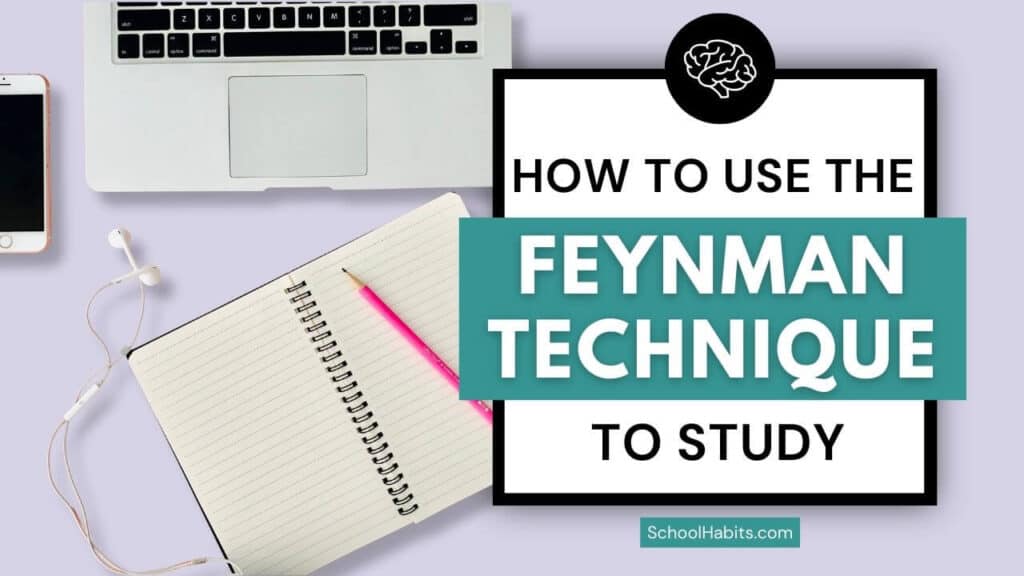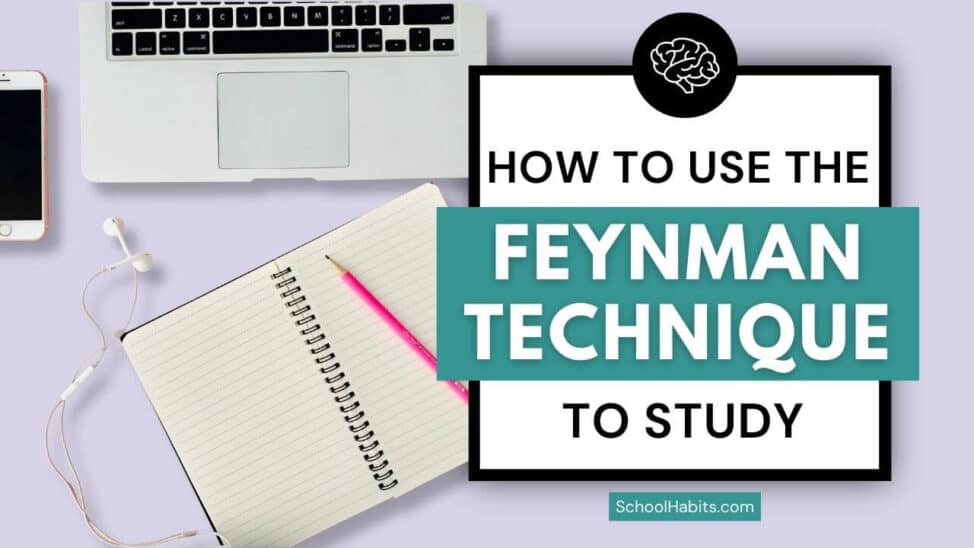By Katie Azevedo, M.Ed.
The Feynman Technique is a 4-step study process that can help you learn material more deeply and more intentionally. In other words, it’s a study method that gets you to learn things better and faster. Yes, please!
If you’ve been around SchoolHabits awhile, and if you’re familiar with the study tips and skills I share here on the blog, on Instagram, and on YouTube, then there’s a good chance you’re already doing bits and pieces of the Feynman Technique without knowing it.
In this blog post, you learn how to use the Feynman Technique to study in a way that’s intentional and systematic. When it comes to studying, intentional and systematic is exactly what you want.
What is the Feynman Technique?
The Feynman Technique was developed by the genius physicist Richard Feynman (1918-1988). He was a Nobel laureate in Physics and contributor to The Manhattan Project (among a long list of other impressive achievements).
Feynman acquired a massive amount of knowledge across multiple areas in a relatively short amount of time. How? According to him, by following a 4-step approach. Today, we call this the Feynman Technique.
The four steps of the Feynman Technique:
- Choose a topic to learn and study it
- Teach the topic to a child
- Identify the gaps in your understanding, and go back to study those missing pieces
- Summarize, simplify, and organize your material
In the sections below, I explain each of the steps to show how you would use them in real life. I’ll also break down step one, as “study it” isn’t clear to most students, and that’s where most people go wrong.
How Does The Feynman Technique Fit into a Study Plan?
Each of the steps in the Feynman Technique has a purpose that’s related to what cognitively happens in our brains when we want to make sense of new information. What this means is that you should follow each step in order.
However, before we dive into each of the four steps, I need you to understand where the Feynman Technique fits into an overall study plan.
First, the Feynman method will not work if you don’t make time for each of the steps. You absolutely cannot pull it off the night before a test as part of a night-before-the-test cram session. Each of the four steps takes time to execute, and depending on the material you’re learning, you’ll need several days or weeks to run through the whole technique multiple times. (This is called spaced repetition and you must must be planning your study sessions using spaced repetition.) Yes, multiple times. Here’s an exact 5-day study plan that you can use with the Feynman Technique.
Second, you have to prepare for the first step of the Feynman Technique. In other words, you can’t begin the first step of the Feynman Technique without doing a few critical things beforehand. Remember, the first step of the Feynman Technique is to choose a topic to learn and study it. In order for this to happen, you need to do the following:
- Figure out what’s on the test
- Organize and consolidate your materials (slides, textbooks, notes, readings, etc.)
- Make your active recall study materials (for example, flashcards)
How to Use The Feynman Technique to Study
Let’s look at each of the 4 parts of the Feynman Technique and break down how each one works.
Step 1: Choose a Topic to Learn and Study It
Here’s where things can get a little funky. Most students don’t know how to use the Feynman Technique to study because they don’t know how to study.
Step one is great, but instructions to “study the material” aren’t helpful to people who don’t know how to study – which is most people.
I have many, many tutorials that teach you exactly how to study. For example, this one, this one and this one. In this one, I teach you how to study less.
The first step in preparing to study, as I outlined in the section above, is to organize and consolidate your resources so you have a reasonable “pile” from which to make your study materials (the next step). You might have class notes in a notebook, a digital pdf reading on your computer, and teacher slides posted in your LMS: the goal is to bring all of these to one central location.
Next, from your resources, make your study materials. These will be the actual “thing” that you study from, using nothing but active recall, of course. The most classic example of active recall study materials are flashcards, but of course there are more.
What comes next is the hard part. It’s the STUDYING part. Using your flashcards or other active recall study materials, put in the cognitive effort required to learn the material. Think about it. Write it. Speak it. Use mnemonic devices. Draw it out. Fill in blank diagrams. Do practice questions. Do textbook review questions. Do the work.
You can use my free study planner template to map out your study sessions over multiple days.
Step 2: Teach the topic to a child
The second step of the Feynman Technique is to teach the topic to a child. As odd as this is, there is a lot of sense behind it and it works.
When we speak to children, we modify our language and simplify what we’re saying so that they can understand us. The cool thing is that if we don’t understand the material, we’ll be unable to simplify it into “child-like” concepts. This is good!
Here’s what this process would look like in real life:
- Find a child.
- If you can’t find a child, find someone who isn’t familiar with the material.
- If you can’t find anybody, find a pillow or a plant.
- One concept at a time, explain the idea in a way that the other person can understand it. Yes, speak out loud, even if you’re talking to a pillow or a plant.
- If you’re unable to clearly articulate the ideas you’re learning, you don’t know them well enough. Similarly, if the other person doesn’t understand the ideas you’re explaining, you don’t know them well enough yet.
- Take note of the words, concepts and ideas that you are unable to explain clearly. You will need them for the next step.
Step 3: Identify the gaps in your understanding, and go back to study those missing pieces
In this tutorial here, I explain how to identify the gaps in your understanding. It’s an important tutorial that will make Step 3 of the Feynman Technique easier.
To study more efficiently, it makes sense to only study what you don’t know. It’s a good feeling to study what you already know, and doing so can make you feel confident and smart, but it won’t help you learn the material or get a good grade on the test.
Once you have a list of concepts that you were unable to summarize and simplify in Step 2, go back and study them again. Here are some ideas for how to do that:
- Write out the concepts multiple times in your notebook (repetition is magic)
- Draw or write the concepts on a whiteboard
- Use your flashcards in reverse
- Use the blurting method (put the concept on the top of a page; write down everything you know about it)
4. Summarize, simplify, and organize your materials
The final step of the Feynman Technique is to summarize, simplify and organize the material you’re learning into a consolidated format. The two simplest formats are a Google Doc or a small notebook if you want to write by hand.
The goal of this step is to create one final “product” that contains all the information you’re studying in an easy-to-read and easy-to-understand format that makes sense to you.
You could do this several different ways. One way is to start with one concept at a time (write it at the top of the page) and define or explain it in the simplest way possible. Then move on to the next concept, and so on.
If you’re using Google Docs, add a table of contents for easy navigation. Use pictures and diagrams if that would help, and consider using analogies whenever possible. For example, if you’re writing an explanation for a complicated concept, and there’s a simple analogy that would make it easier to understand, write that analogy in your notes.
Final Notes on Using the Feynman Technique to Study
The Feynman Technique works. It’s a great way to structure your study sessions in a 4-step process that ensures that you really know the content.
Each step has a purpose. Step 1 (pick a topic to study and study it) gets you using active recall study methods. Step 2 (teaching it to a child) tests your comprehension – which is exactly what you want. Step 3 (focus on gaps) forces you to confront what you don’t know – which is also exactly what you want. And Step 4 (summarize, simplify and organize) helps you consolidate large amounts of material into something you can understand.
If you start the study process well enough in advance (at least 5 days), you can complete one or more steps of the Feynman Technique per day, repeating the cycle as necessary.


